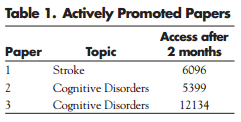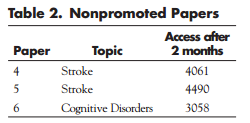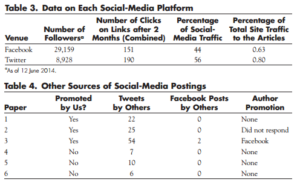Introduction

Journals are increasingly using social media to promote their content. As audiences are made up more and more of people who grew up in the age of social media, it is becoming increasingly important to reach out to this group of users.
The journal Neurology began using Facebook and Twitter in late 2009, and Google+, YouTube, and Pinterest came later. With a combination of manual and feed-based postings, we now post our content an average of 15 times a week per venue. Our goal with social media was simply to increase the traffic to our journal Web site (www.neurology.org). A large portion of journals that have an online presence rely on traffic to their site to help with advertising sales, and the greater the traffic, the more valuable advertising space becomes. However, using an organization’s social-media sites correctly is important. A study on the age group known as Millennials points out that many members of the group would stop being fans of an organization if there were too much engagement or not enough.1
Compared with some popular Facebook pages, Neurology was not receiving many “likes”, comments, or retweets on our regular posts. We did not have much staff time to devote to our social-media program, so we decided to measure whether social media were helping us to achieve our goal even without a great deal of user engagement. We also wanted to determine which socialmedia venue was providing us with the highest percentage of traffic so that we could devote more attention to it in the limited time available.
Methods
Six articles on similar topics were chosen from a single issue of Neurology. Three served as controls, and three served as papers that we actively promoted through social media. The URLs of the promoted articles were shortened by using link-shortening sites (bit.ly and owl.ly). Each social-media site used a different shortened link so that we could determine the source of the traffic. Daily posts for 1 week (starting with the day an article was published) were uploaded on both venues, all at the same time to minimize the chance of posting during periods of altered site traffic and avoid skewing the results. Altmetrics was used to determine social-media applications from other sources, and the authors were queried on their own social-media promotion of the articles.
Results
 We found that the papers promoted on social media had an average of 7876 hits (Table 1). Those without any social-media promotion had an average of 3870 hits (Table 2).
We found that the papers promoted on social media had an average of 7876 hits (Table 1). Those without any social-media promotion had an average of 3870 hits (Table 2).
Once we had the data, we looked at the social-media venues that had been used.
 Relative to all the hits that a paper had received, traffic from our social-media accounts was very low (less than 1%). Inasmuch as our goal is to use social media to drive traffic to our Web site, that was not an encouraging result. See Table 3 for more information.
Relative to all the hits that a paper had received, traffic from our social-media accounts was very low (less than 1%). Inasmuch as our goal is to use social media to drive traffic to our Web site, that was not an encouraging result. See Table 3 for more information.
 Altmetrics were compared for the papers, so we could get a general sense of social-media usage for each paper (Table 4). The three papers that we promoted through our social-media accounts had a higher number of tweets from other users. Facebook again had a much lower rate of postings. We also asked the papers’ authors whether they had done any of their own social-media postings about their papers.
Altmetrics were compared for the papers, so we could get a general sense of social-media usage for each paper (Table 4). The three papers that we promoted through our social-media accounts had a higher number of tweets from other users. Facebook again had a much lower rate of postings. We also asked the papers’ authors whether they had done any of their own social-media postings about their papers.
It was interesting that the only paper for which the authors used social media had the highest access numbers. We cannot determine how many hits came from author posts, but it might be interesting to do more research.
Conclusion
Social media allow journals to connect with their audiences in a personal way. Although we were not receiving many responses on our social-media sites, our study showed that it was worth our time to continue using social media, but it might not be worthwhile to increase the time spent at this point. As new venues are created, more research will be needed to determine their value. Neurology uses other venues, such as Pinterest, Google+, and YouTube, but we recognize that for now Facebook and Twitter have the most value.
Social media have uses other than driving traffic: Brand recognition, promoting announcements, and highlighting new features are a few. Inasmuch as most journals are using social media, we believe that it is necessary to continue using them if it does not take up too much staff time.
Our study had limitations. Some articles might be of more interest than others and have higher access rates. Readers might have shared some of the control articles by using their own social-media accounts, and this could further prove the value of social media in general (not just the journals’ use of them). By using Altmetrics, we were able to determine that nearly 100 other accounts were tweeting about the papers that we were actively promoting and 23 about the control papers, so these accounts could be providing more traffic for the papers than we realize.
Given our larger audience on Facebook, we were surprised to find that we had more interaction with Twitter. In a recent study, Facebook was more popular than Twitter among millennials trying to connect with a company, so we had expected Facebook to be our larger driver of traffic.2 However, given the new data, we will be putting more effort into our Twitter account in hopes of continuing to increase our traffic.
References
- McCorkindale T, DiStaso MW, Sisco H. How millennials are engaging and building relationships with organizations on Facebook. The Journal of Social Media in Society 2013:2:1. http://thejsms.org/index.php/TSMRI/article/view/15. Accessed 19 March 2014.
- Barnes NG, Lescault AM. Millennials drive social commerce: Turning their likes, follows or pins into a sale. www.umassd.edu/cmr/socialmediaresearch/socialcommerce/. Accessed 19 March 2014.
MORGAN S SORENSON is managing editor of Neurology® Neuroimmunology & Neuroinflammation, Minneapolis, Minnesota. This report details her project required for completion of the CSE Publication Certificate Program.
